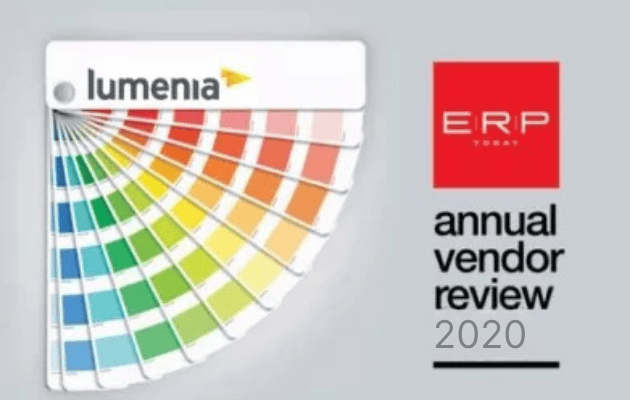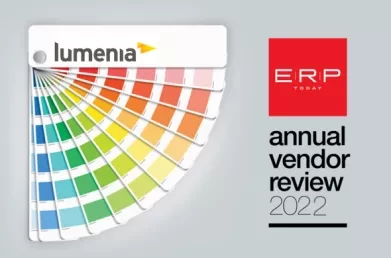The ERP Market in 2020
It remains unclear the extent to which the developing COVID-19 crisis will impact different sectors of the economy, and from our perspective what it will mean for ERP. We can expect to see some sectors slowing significantly and deferring planned projects. Some organisations may find increased capacity due to other project deferrals and chose to capitalise on this. Other sectors will see an unexpected growth as economies refocus, and this may in turn drive a need for ERP, and IT in general, investment. Suffice to say, some of you may be considering ERP projects on the horizon. A quick assessment of the current offerings on the ERP market may be of use.
Earlier this year Lumenia partnered with ERP Today magazine to prepare and publish an ERP market review. We analysed 10 leading vendor offerings. An extract from our introduction is provided below and focuses on some key trends we noted in our research. You can download the full report at Lumenia ERP Today Annual Vendor Review 2020

Functionality Trends
Business software in general has seen the impact of the consumerisation of IT on user expectations and has had to respond. Newer generations of users expect all software interactions to be a simple as the mobile apps and websites that they use in daily life outside of work. ERP vendors, like others have responded. The clunky interfaces of legacy suites have largely been replaced by more user-friendly intuitive UI’s. User interaction constructs have been deployed by many vendors that mimic our interactions on social media or with chat bots.
See also Evolution of Mobile ERP software
Most vendors have incorporated functionality or tools to leverage AI (Artificial Intelligence) and RPA (Robotic Process Automation) capabilities now widely available. These are bringing efficiencies to repetitive and administrative tasks and freeing up capacity for more value-adding and fulfilling work. IoT (Internet of Things) data-feeds are being incorporated into ERP processes, particularly in manufacturing and asset intensive implementations.
HCM (human capital management) has become a key focus of many ERP vendors. Perhaps instigated by the rise of Workday it was one of the early lines of business that lent itself to a cloud ERP model where implementations that touched physical processes, such as manufacturing, were slower to adopt. SAP, Oracle and others followed suit with acquisition and development. Microsoft has joined the party more recently.
Cloud ERP Trends
This migration of ERP to the cloud has continued at pace albeit after a slow start. The variety of cloud solutions can be seen in the Vendor Review Report. There is still a variety of cloud deployment models, reflecting perhaps the need amongst buyers for options as much as differing pace of development and technical evolution amongst vendors. With few exceptions, ERP vendors are pushing this trend. Whether this is a reaction to customer demand for OpEx based investment or technology vendor shareholder demand for predictable revenue is debatable. Regardless of the financial aspects of the cloud migration, most CIO’s and IT Managers are happy to move some of the technical overhead of managing complex ERP solutions outside.
SAP’s recently announced slowdown in cloud bookings and extension of support for its legacy ECC6 (non-cloud) suite however are examples illustrating that there is not, and probably never will be, a one size fits all approach to cloud ERP.
Architectural Trends
There has been a trend in recent years to de-couple the components of the vendor suites into their constituent parts. This is partly enabled by technology (SOA based integration), partly driven by market dynamics (acquisitions are easier to integrate in a SOA environment than to bake into a different code base) and partly driven by commercial considerations (enabling clients to pick subscriptions from a shopping list of options). Almost all of the leading suites described in the Report are actually made up of multiple components now. ERP buyers should understand this. Contrary to many tech commentators’ views that big suites are too complex, many buyers still like to think that one solution supporting everything is easier to manage than multiple moving parts with different integrations to manage. This may not be what they are buying, despite branding.
Commercial Market Trends
Finally, it is worth stating that the ERP market has remained vibrant coming into 2020, if not as headline grabbing as some newer technology markets. The reality is that many of these new technologies enable most benefit when integrated to or coupled with processes that are recorded and transacted in ERP systems. Continued equity investment in the market and continuing acquisitions are testament to this vitality. As ERP vendors offerings continue to mature, they are broadening their reach into CX and other Digital technologies.
Read more detail in the Lumenia ERP Today Annual Vendor Review 2020 where you will find profiles of the ERP offerings from Advanced, Epicor, IFS, Infor, Microsoft, QAD, Sage, SAP, Unit4 and Workday.
This blog was written by Ian O'Toole, Managing Partner at Lumenia. For further information please send an email to Ian O'Toole


